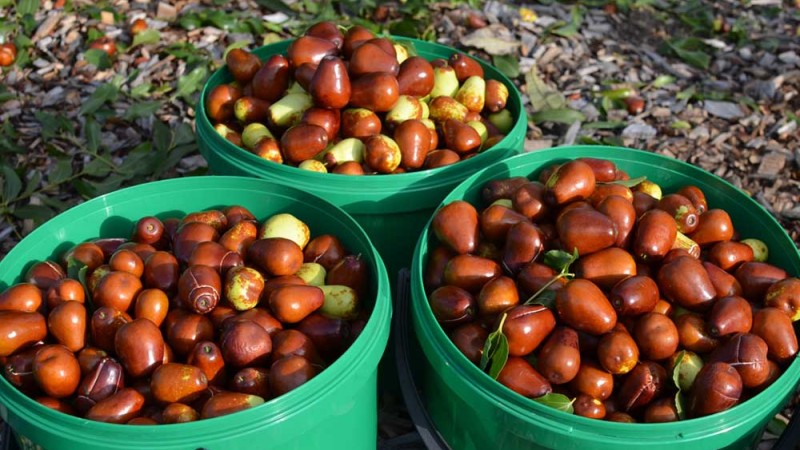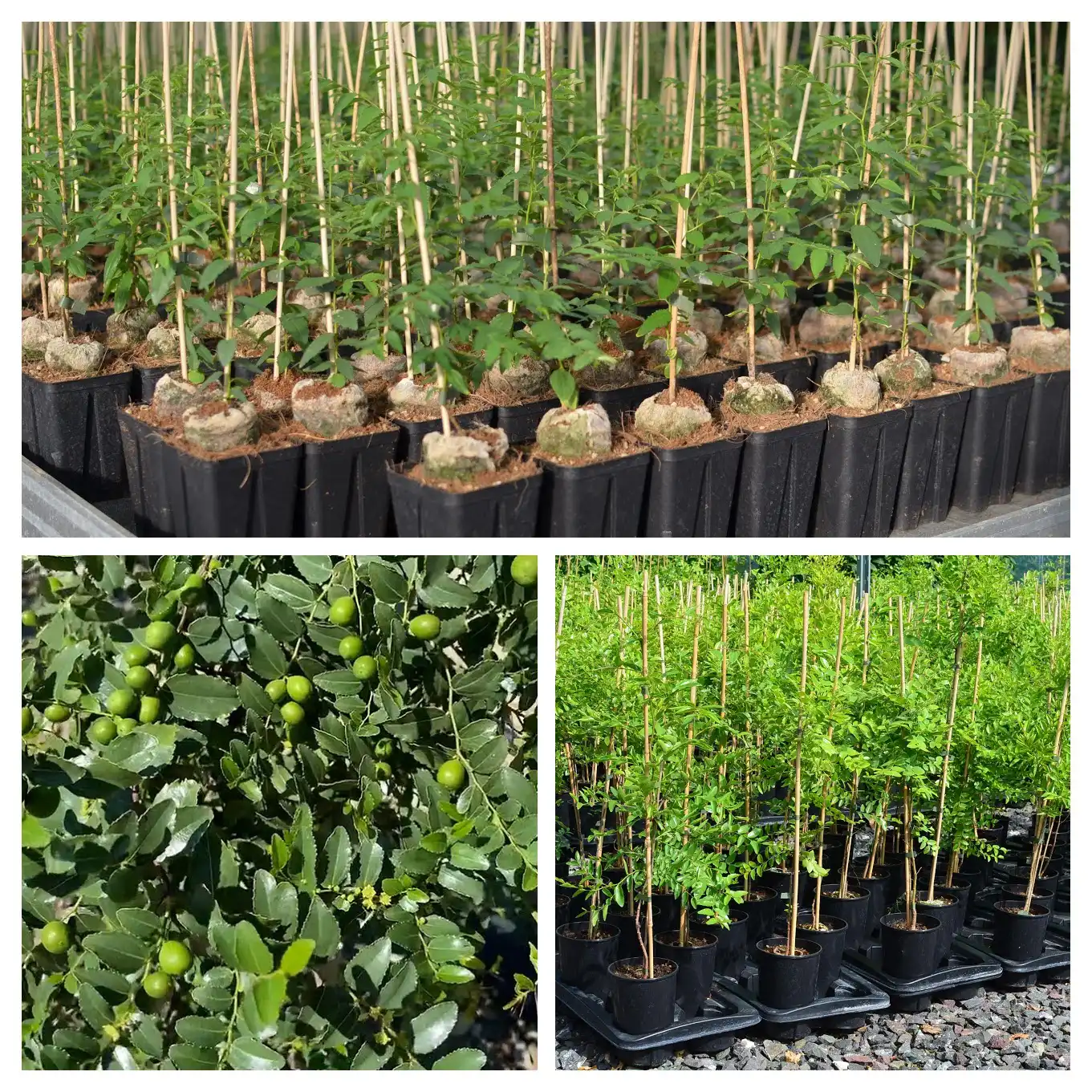
Jujube (Ziziphus jujuba Mill.), also known as Chinese jujube or Chinese date, is one of the oldest cultivated fruit trees in the world and the most important species in the extensive Rhamnaceae family. It originates from the middle and lower reaches of the Yellow River and is widespread throughout China. Its cultivated area covers 2 million hectares, and annual production exceeds 8 million tons. Since its introduction to neighboring countries such as Korea and Japan 2,000 years ago, it has spread to at least 48 other countries. Commercial cultivation of jujube has developed at various levels in China, South Korea, Iran, Israel, the United States, Italy, Australia, and other countries. Due to its excellent resistance and adaptability to drought, as well as infertile and saline soils, jujube is gaining increasing importance in arid and semi-arid marginal regions and, due to its unique benefits, deserves to be considered a fruit of the future.
Fruit of the future
The fruit of the future should simultaneously meet the needs of growers, processors, consumers and marketers. Generally, growers prefer fruit trees that bear crop early, reach high and stable yields quickly, and have light pest pressure, easy management, low cultivation costs, and high economic benefits. Consumers value delicious and nutritious fruit that is also visually appealing. Marketers prefer fruits that can be easily transported and have long shelf lives and large markets. Jujube clearly deserves to be considered a fruit of the future.
Basic characteristics
Jujubes optimally meet the various needs of growers. They can flower and even bear fruit in the same year they are planted or grafted, and with dense planting, they achieve high yields 3 to 5 years after the orchard is established. Thanks to their late budding (20 days later than peaches), late flowering (from June) and two-month flowering period, jujubes avoid late frosts and biennial bearing. In addition, the tree withstands winter frosts well. Thanks to their unique self-pruning habits, they only require light pruning: the shoots that have borne fruit in the fall fall off spontaneously after harvest. Jujubes are highly tolerant to drought and salinity, and have low low demands for water and fertilizers. Consequently, the costs of cultivation and management for jujube are significantly lower than those for other common fruit species.
Jujube fruits meet the diverse demands of consumers
The fruits have an attractive appearance, are smooth and shiny, have a delicious taste, the flesh is sweet as honey and crispy as an apple or pear. The fruit is particularly rich in nutrients, and its content of sugar, vitamin C and B, potassium, iron and zinc is one of the highest among fruit species. The content of sugar, vitamin C is several times higher than that of apples. The fruit is also a rich source of polysaccharides and antioxidants. It is a medicinal food commonly used in traditional Chinese herbal medicine recipes. Jujube fruits also have very positive meanings in Chinese culture, such as for sweet life, flourishing business, fertility, harmony and happiness.
Jujube fruits meet the needs of processors and marketers
The fruits are easy to store and transport. Dried jujubes can be stored for more than a year at room temperature and two to three years at 4 °C. Fresh jujube fruits can be stored for 2 to 4 months under controlled atmosphere or at a controlled freezing point. They have multiple uses as fresh or dried fruits, processing materials, in traditional Chinese medicine, as a celebratory food and as a health product. They have great potential in international markets.
China's Jujube Gene Pool
Based on the nationwide genetic material research, the National Chinese Jujube Repository was constructed in Taigu, Shanxi Province, by the Ministry of Agriculture and Rural Affairs of the People’s Republic of China. To date, a total of 930 jujube genotypes have been preserved, accounting for at least 90% of the total jujube genotypes in the world. Another gene pool repository was constructed in Cangxian, Hebei Province. It contains 640 kinds of genotypes, including several excellent local varieties such as "Jinsixiaozao", "Wuhezao" and "Dongzao". The International Cultivar Registration Center for the Ziziphus genus was established in 2014 at the Research Center of Chinese Jujube, Hebei Agricultural University.
Evaluation of elite genetic material with unique features
To date, 700 jujube varieties have been evaluated. A number of excellent genotypes have been identified, including triploid genotypes such as "Zanhuangdazao", "Pingguozao", "Jinglinyihaozao", "Shanxitedage", "Hengshuibianzhizao", "Zhenhuluzao", the mixoploid genotype "Dongzao 2", the self-sterile genotypes "Huizao", "Jinsixiaozao 39", "Yuanlingzao" and "Xiangzao", the tortuous-branched genotype "Dongzao", the stoneless genotype "Wuhexiaozao", genotypes that are highly resistant to diseases such as "Xingguang", as well as genotypes rich in functional nutrients.
Clarification of the ancestor of jujube and the original cultivation center
In the book "Qi Min Yao Shu", published 1500 years ago, it is recorded that the ancient Chinese selected and cultivated trees with the best tasting fruits of the wild thorny jujube (Ziziphus spinosa). Based on a systematic study of ancient books, ecological distribution, as well as the transitional types between jujube and thorny jujube, it is believed that jujube evolved from the wild thorny jujube.

According to the unearthed carbonized fruits, jujube was cultivated and utilized in China 7000 years ago. After studying ancient documents, fossils and modern distributions as well as the transitional genotypes of jujube and thorny jujube, it was found that jujube originated in the Yellow River Valley. The earliest records and evidence from Iran and Japan date back to 2000 years ago, when Sino–Japan trade exchanges became popular and the imperial envoy Zhang Qian was sent on a diplomatic mission to West Asia and European countries during the Han Dynasty. In Iran, all the jujube trees that were hundreds of years old were located at key sites on the ancient Silk Road.
Breeding objectives
Specific breeding objectives include outstanding jujube resistance to biotic and abiotic stress, dwarf growth, low branching ability, thornlessness, early bearing, high and stable yields, high quality, large fruits, stonelessness, high nutrient content, various ripening times, easy transportation and storage.
Given the limitations of traditional hybrid breeding in obtaining breakthrough cultivars and the extreme difficulty of crossing in jujuba, polyploid breeding appears to be a promising prospect. Crossbreeding, the most effective method of fruit tree breeding, is mostly unsuccessful in jujuba. The hybrid yield rate in jujuba in traditional crosses is usually less than 0.01%.
New varieties with different ripening times and uses
Over the past 30 years, a total of 200 new varieties with large fruits, good fruit quality, high disease resistance, and diverse uses and ripening times have been released through polyploid breeding or selection from seedlings, bud mutants, and local genetic material. The tetraploid varieties "Chenguang," "Hongguang," "Riguang," and "Zhuguang," bred by Hebei Agricultural University, have been granted plant variety protection. The fruits of the tetraploid varieties were 30–50% larger, ripened 4–7 days earlier, and tasted better than diploid fruits. Recently, some excellent new varieties for fresh consumption, such as "Jinsi 4", "Yueguang", "Zaohongmi", "Zaocumi" and "Zaoqiuhong", as well as some for drying, such as "Yuangling 2", "Shuguang", "Zanshuo", "Yushuai" and "Linhuang 1", have become dominant varieties with larger fruits, higher quality and higher resistance to fruit diseases than traditional varieties. These dominant varieties have replaced traditional varieties, significantly improving the variety structure in China.
Constructing a high-efficiency propagation system
A set of new propagation approaches has been developed on the basis of traditional sucker division. Jujube hardwood cuttings are quite difficult to propagate, presenting a rooting rate of usually less than 30%, and have rarely been used in commercial production. However, green shoot cuttings root much more easily and have a high reproductive coefficient. The rooting rate can reach as high as 95%, but its cost and technical requirements are relatively higher than those of other propagation techniques.
Judging from old grafted jujube trees, grafting has been used for at least 1000 years. To meet the needs of largescale development, grafting propagation with thorny jujube as the rootstock has been widely used since the late 1980s. This means that grafting onto Ziziphus spinosa is the main method of propagating jujube, not in-vitro, not propagation by cuttings.
Jujube tissue culture propagation (in-vitro) began in 1978. After 1995, the research on jujube tissue culture increased rapidly. However, propagation via tissue culture has not been used on a large scale in jujube in China because of the high technical requirements, high cost, and late fruiting of micropropagated plants.
Traditional orchard improvement and high-density plantations
Since the 1980s, various yield-oriented cultivation techniques have been developed. These have increased production by over 50%, increased the proportion of high-quality fruit by over 30%, and reduced pesticide use by over 50%. At the same time, traditional sparse planting systems with large crowns (row spacing and plant height above 5 m) have been replaced by dense dwarf plantations (2 m × 3 m), and even super-dense plantations with a density of up to 15,000 plants per hectare have been established. In the early 21st century, a new cultivation model for high early yields and high fruit quality was established in the desert of southern Xinjiang Province, China. This method is characterized by direct sowing of the rootstock seeds of thorny jujube (Ziziphus spinosa) in orchards, followed by in-situ grafting of the target variety. This new model obtains good yields (5-8 t/ha) in the year of grafting and maintains high yields of over 15 t/ha 3 to 5 years later, which is 3 to 5 years earlier than this yield could be achieved in a traditional orchard.
Storage and processing of jujube fruits
Jujube fruit is difficult to keep fresh. Under normal room temperature and humidity conditions, fresh jujube quickly loses its moisture and crispness within 3 to 5 days.

Fresh storage
Practical techniques include cold storage, controlled atmosphere storage, decompression storage, and controlled freezing-point storage. Jujube is sensitive to CO₂ and fruit browning occurs rapidly at 10% CO₂. The best storage conditions for fresh jujube are at a temperature of −1 to −2 °C, relative humidity of 95%, 2% O₂ and 0% CO₂. Currently, under the optimal storage conditions, semi-colored fresh jujube can be preserved for 2 to 3 months or even more than 4 months.
Drying
Fruit drying technology has gradually changed from the traditional natural sun drying to dehydration in a drying rooms or dryers. Natural drying or air drying takes a month, while artificial drying shortens this time to one day or less. Compared with natural drying, artificial drying significantly improves the retention rate of vitamin C, total sugar, sucrose, fructose, glucose, soluble protein and other nutrients.
Diverse processing techniques
There are many traditional processed jujube products, such as candied jujube, smoked jujube, stoneless sugared jujube, jujube liquor, jujube wine, jujube jam, jujube paste, and more. Over the past 30 years, various new products have been developed, including jujube juice, jujube powder, jujube slices, jujube tea, jujube beer, jujube essence, and jujube pigment. Since the beginning of the 21st century, intensive processing that enhances jujube's characteristic nutrients has received significantly more attention. A number of new products with high nutritional value have been developed, such as jujube polysaccharides, jujube oil, instant jujube powder, and vitamin C-rich juice.









